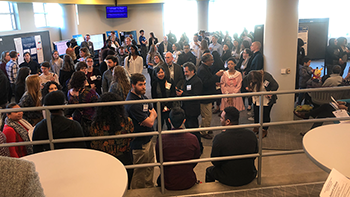Biophysical Characterization of the Full-Length Par-4 Tumor Suppressor
Description/Abstract/Artist Statement
Tumor suppressor proteins are responsible for important cellular functions, such as DNA repair and cell apoptosis. The Prostate Apoptosis Response-4 (Par-4) tumor suppressor is encoded by the Par-4/ PaWR gene found in chromosome 12q21.2. The 38 kilodalton full-length Par-4 (FL)-Par-4 has been shown to induce cell apoptosis in response to various stimuli in different cellular systems. However, FL-Par-4 protein is intrinsically disordered under neutral conditions in vitro. Par-4 translocates into the nucleus for cell apoptosis induction only after it is cleaved by the caspase-3 at aspartic acid 131. The reason for this cleavage requirement has not yet been determined. Our previous research with the caspase-3-cleaved fragment (cl- Par-4) have shown that ordered protein structure can be induced by either acidic conditions or by a high concentration of monovalent cations. In this study, we are investigating whether similar conditions also induce structure into (FL) Par-4. Determining FL Par-4 structure will enhance our understanding of structural similarities and differences between the FL Par-4 and cl-Par-4 fragment. Preliminary circular dichroism (CD) data of FL Par-4 show that both monovalent and divalent cations do affect the degree of structure in FL-Par-4. Additional techniques, such as tyrosine fluorescence, size exclusion chromatography with multi angle scattering (SEC-MALS), and dynamic light scattering (DLS) will also be used to characterize FL Par-4 structure under various conditions. These results will increase our understanding of Par-4 structure in relation to the cellular environment and how cleavage alters Par-4 structure, including the ability of Par-4 to be induced to fold via various stimuli.
Faculty Advisor/Mentor
Steven M. Pascal
Presentation Type
Poster
Disciplines
Biochemistry, Biophysics, and Structural Biology
Session Title
Poster Session
Location
Learning Commons, Atrium
Start Date
2-8-2020 8:00 AM
End Date
2-8-2020 12:30 PM
Biophysical Characterization of the Full-Length Par-4 Tumor Suppressor
Learning Commons, Atrium
Tumor suppressor proteins are responsible for important cellular functions, such as DNA repair and cell apoptosis. The Prostate Apoptosis Response-4 (Par-4) tumor suppressor is encoded by the Par-4/ PaWR gene found in chromosome 12q21.2. The 38 kilodalton full-length Par-4 (FL)-Par-4 has been shown to induce cell apoptosis in response to various stimuli in different cellular systems. However, FL-Par-4 protein is intrinsically disordered under neutral conditions in vitro. Par-4 translocates into the nucleus for cell apoptosis induction only after it is cleaved by the caspase-3 at aspartic acid 131. The reason for this cleavage requirement has not yet been determined. Our previous research with the caspase-3-cleaved fragment (cl- Par-4) have shown that ordered protein structure can be induced by either acidic conditions or by a high concentration of monovalent cations. In this study, we are investigating whether similar conditions also induce structure into (FL) Par-4. Determining FL Par-4 structure will enhance our understanding of structural similarities and differences between the FL Par-4 and cl-Par-4 fragment. Preliminary circular dichroism (CD) data of FL Par-4 show that both monovalent and divalent cations do affect the degree of structure in FL-Par-4. Additional techniques, such as tyrosine fluorescence, size exclusion chromatography with multi angle scattering (SEC-MALS), and dynamic light scattering (DLS) will also be used to characterize FL Par-4 structure under various conditions. These results will increase our understanding of Par-4 structure in relation to the cellular environment and how cleavage alters Par-4 structure, including the ability of Par-4 to be induced to fold via various stimuli.


